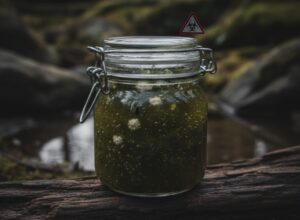
Sea moss gel has become a popular superfood thanks to its rich mineral and vitamin content. Many people use it daily to support immunity, digestion, and overall wellness. But what happens if you eat expired sea moss gel? Like any perishable food, consuming spoiled sea moss can pose health risks, from mild digestive discomfort to more serious foodborne illness. In this article, we’ll break down everything you need to know, including the signs of spoilage, potential health effects, and safe storage tips.
Understanding Sea Moss Gel and Its Shelf Life
Sea moss gel is made by soaking, blending, and storing dried seaweed in water. Its high moisture content makes it nutrient-rich but also perishable. Typically, fresh sea moss gel can last 2–3 weeks in the refrigerator and up to 6 months if frozen. Consuming it past its expiration date increases the risk of bacterial growth and spoilage, which can compromise both safety and nutritional value.
Even though it may look harmless, expired gel can harbor harmful microorganisms, toxins, or molds that can negatively affect your health.
Health Risks of Eating Expired Sea Moss Gel

Eating expired sea moss gel can lead to several health issues. Understanding these risks helps you make safer decisions and avoid unnecessary complications.
1. Foodborne Illness
The most common risk is food poisoning, caused by bacteria such as Clostridium botulinum or Salmonella that may develop in expired gel. Symptoms typically include:
- Nausea
- Vomiting
- Diarrhea
- Stomach cramps
These symptoms usually appear within hours to a couple of days after consumption and can range from mild to severe depending on your immune system and overall health.
2. Allergic Reactions
Expired gel can produce altered compounds, which may trigger an allergic response. Signs can include:
- Rash or hives
- Itching
- Swelling
- Difficulty breathing (in rare severe cases)
If you experience severe allergic reactions, seek immediate medical attention.
3. Worsening of Pre-Existing Conditions

Individuals with compromised immune systems, gastrointestinal issues like IBS, or chronic illnesses are more susceptible to severe complications from spoiled foods. Eating expired sea moss gel may exacerbate symptoms or lead to prolonged recovery.
4. Decreased Nutritional Benefits
As sea moss gel spoils, its vitamins and minerals degrade, meaning you won’t receive the full intended benefits. This is especially important if you rely on sea moss for its nutrient density.
Signs Your Sea Moss Gel Has Gone Bad
Before consuming any gel, it’s important to check for obvious signs of spoilage. Here’s what to look for:
| Signs of Spoilage | What It Means |
| Mold Growth | Fuzzy spots or discoloration indicate bacterial or fungal contamination. |
| Sour or Unpleasant Smell | Gel should smell light and ocean-like; a strong, offensive odor means it’s spoiled. |
| Changes in Texture | Watery, slimy, or overly thick gel is a warning. |
| Color Changes | Natural gel is light beige/tan; darkening or unusual colors signal spoilage. |
| Fizzy or Fermented Taste | Any unusual, fermented taste indicates bacterial activity. |
Checking for these signs is the simplest way to prevent accidental ingestion of expired gel.
What To Do If You Have Eaten Expired Sea Moss Gel

If you realize you’ve eaten expired sea moss gel, don’t panic. Most mild cases resolve naturally, but monitoring and supportive care are important.
1. Stay Hydrated
Drinking plenty of water helps your body flush out toxins and maintain proper hydration, especially if vomiting or diarrhea occurs. Electrolyte drinks may also help restore balance.
2. Monitor Your Symptoms
Keep an eye on your condition for any persistent or worsening symptoms, such as fever, severe abdominal pain, or prolonged vomiting.
3. Seek Medical Attention
Consult a doctor if:
- Symptoms last more than a couple of days
- You experience high fever or severe dehydration
- You are pregnant, elderly, or immunocompromised
Medical professionals can provide treatment for food poisoning or allergic reactions if necessary.
Tips for Proper Storage of Sea Moss Gel
Preventing spoilage is much easier than treating it. Proper storage can prolong freshness and maintain nutritional value.
1. Refrigerate Promptly
Store sea moss gel in a sealed container in the coldest part of your fridge (usually the back). Avoid leaving it at room temperature for extended periods.
2. Use Clean Utensils
Always use clean spoons or spatulas to scoop out gel. Introducing contaminants can accelerate spoilage.
3. Freeze for Long-Term Storage
If you don’t plan to consume the gel within 2–3 weeks, freezing it is the best option. Portion it into small containers or ice cube trays for easy use.
4. Follow Expiration Dates
Even with proper storage, gel has a limited shelf life. Always check the date and discard expired portions.
Quick Table: Expired vs. Fresh Sea Moss Gel
| Feature | Fresh Gel | Expired Gel |
| Smell | Mild, ocean-like | Sour, pungent, or fermented |
| Texture | Smooth, gel-like | Slimy, watery, or overly thick |
| Color | Light beige/tan | Darkened, green, pink, or unusual |
| Safety | Safe for consumption | Risk of foodborne illness and allergic reactions |
| Nutritional Value | Rich in minerals and vitamins | Degraded, reduced benefits |
 FAQs About Expired Sea Moss Gel
FAQs About Expired Sea Moss Gel
Q1: How long does sea moss gel last in the fridge?
A: Typically 2–3 weeks in the refrigerator. For longer storage, freezing is recommended.
Q2: Can expired sea moss gel cause severe illness?
A: Most cases are mild, but it can be dangerous for pregnant women, children, elderly, or immunocompromised individuals.
Q3: Is it safe to eat sea moss gel with a slightly sour smell?
A: No, any sour or off smell indicates bacterial growth and potential spoilage.
Q4: Can I eat sea moss gel after freezing it?
A: Yes, freezing preserves the gel’s freshness. Use it within 6 months for best quality.
Q5: What should I do if I accidentally eat expired sea moss gel?
A: Drink plenty of fluids, monitor symptoms, and consult a doctor if symptoms persist or worsen.
Conclusion
Eating expired sea moss gel can be risky. Spoiled gel can cause food poisoning, allergic reactions, and digestive discomfort, while also losing its nutritional benefits. Since many people choose sea moss for its rich nutrient profile—often asking how many minerals does sea moss have—it’s important to only consume it when fresh. By inspecting for signs of spoilage, storing gel properly, and discarding expired portions, you can safely enjoy sea moss as part of your daily wellness routine.
Remember: “When in doubt, throw it out.” Never consume sea moss gel if you notice mold, off smells, texture changes, or discoloration. Staying safe ensures you reap the superfood’s benefits without unwanted health issues.


